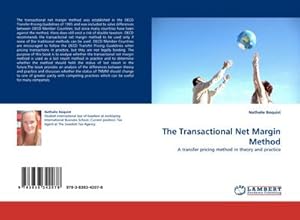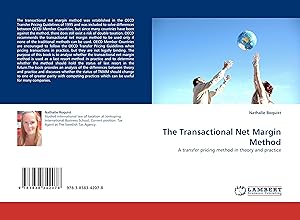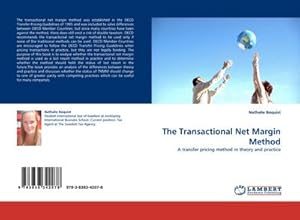transactional net margin method de boquist nathalie (4 resultados)
ComentariosFiltros de búsqueda
Tipo de artículo
- Todos los tipos de productos
- Libros (4)
- Revistas y publicaciones (No hay ningún otro resultado que coincida con este filtro.)
- Cómics (No hay ningún otro resultado que coincida con este filtro.)
- Partituras (No hay ningún otro resultado que coincida con este filtro.)
- Arte, grabados y pósters (No hay ningún otro resultado que coincida con este filtro.)
- Fotografías (No hay ningún otro resultado que coincida con este filtro.)
- Mapas (No hay ningún otro resultado que coincida con este filtro.)
- Manuscritos y coleccionismo de papel (No hay ningún otro resultado que coincida con este filtro.)
Condición Más información
- Nuevo (4)
- Como nuevo, Excelente o Muy bueno (No hay ningún otro resultado que coincida con este filtro.)
- Bueno o Aceptable (No hay ningún otro resultado que coincida con este filtro.)
- Regular o Pobre (No hay ningún otro resultado que coincida con este filtro.)
- Tal como se indica (No hay ningún otro resultado que coincida con este filtro.)
Encuadernación
- Todas
- Tapa dura (No hay ningún otro resultado que coincida con este filtro.)
- Tapa blanda (4)
Más atributos
- Primera edición (No hay ningún otro resultado que coincida con este filtro.)
- Firmado (No hay ningún otro resultado que coincida con este filtro.)
- Sobrecubierta (No hay ningún otro resultado que coincida con este filtro.)
- Con imágenes (4)
- No impresión bajo demanda (1)
Idioma (1)
Precio
- Cualquier precio
- Menos de EUR 20 (No hay ningún otro resultado que coincida con este filtro.)
- EUR 20 a EUR 45
- Más de EUR 45
Gastos de envío gratis
- Envío gratis a España (No hay ningún otro resultado que coincida con este filtro.)
Ubicación del vendedor
Valoración de los vendedores
-
The Transactional Net Margin Method
Publicado por LAP LAMBERT Academic Publishing Jul 2010, 2010
ISBN 10: 3838342070 ISBN 13: 9783838342078
Idioma: Inglés
Librería: buchversandmimpf2000, Emtmannsberg, BAYE, Alemania
EUR 49,00
Convertir monedaEUR 35,00 gastos de envío desde Alemania a EspañaCantidad disponible: 2 disponibles
Añadir al carritoTaschenbuch. Condición: Neu. Neuware -The transactional net margin method was established in the OECD Transfer Pricing Guidelines of 1995 and was included to solve differences between OECD Member Countries, but since many countries have been against the method, there does still exist a risk of double taxation. OECD recommends the transactional net margin method to be used only if none of the traditional methods can be used. OECD Member Countries are encouraged to follow the OECD Transfer Pricing Guidelines when pricing transactions in practice, but they are not legally binding. The purpose of this book is to analyse whether the transactional net margin method is used as a last resort method in practice and to determine whether the method should hold the status of last resort in the future.The book provides an analysis of the differences between theory and practice and discusses whether the status of TNMM should change to one of greater parity with competing practices which can be useful for many companies.Books on Demand GmbH, Überseering 33, 22297 Hamburg 72 pp. Englisch.
-
The Transactional Net Margin Method
Publicado por LAP LAMBERT Academic Publishing Jul 2010, 2010
ISBN 10: 3838342070 ISBN 13: 9783838342078
Idioma: Inglés
Librería: BuchWeltWeit Ludwig Meier e.K., Bergisch Gladbach, Alemania
EUR 49,00
Convertir monedaEUR 11,00 gastos de envío desde Alemania a EspañaCantidad disponible: 2 disponibles
Añadir al carritoTaschenbuch. Condición: Neu. This item is printed on demand - it takes 3-4 days longer - Neuware -The transactional net margin method was established in the OECD Transfer Pricing Guidelines of 1995 and was included to solve differences between OECD Member Countries, but since many countries have been against the method, there does still exist a risk of double taxation. OECD recommends the transactional net margin method to be used only if none of the traditional methods can be used. OECD Member Countries are encouraged to follow the OECD Transfer Pricing Guidelines when pricing transactions in practice, but they are not legally binding. The purpose of this book is to analyse whether the transactional net margin method is used as a last resort method in practice and to determine whether the method should hold the status of last resort in the future.The book provides an analysis of the differences between theory and practice and discusses whether the status of TNMM should change to one of greater parity with competing practices which can be useful for many companies. 72 pp. Englisch.
-
The Transactional Net Margin Method
Publicado por LAP LAMBERT Academic Publishing, 2010
ISBN 10: 3838342070 ISBN 13: 9783838342078
Idioma: Inglés
Librería: moluna, Greven, Alemania
EUR 41,05
Convertir monedaEUR 19,49 gastos de envío desde Alemania a EspañaCantidad disponible: Más de 20 disponibles
Añadir al carritoCondición: New. Dieser Artikel ist ein Print on Demand Artikel und wird nach Ihrer Bestellung fuer Sie gedruckt. Autor/Autorin: Boquist NathalieStudied international law of taxation at Jonkoping International Business School, Current position: Tax Agent at The Swedish Tax Agency.The transactional net margin method was established in the OECD Transfer Pr.
-
The Transactional Net Margin Method : A transfer pricing method in theory and practice
Publicado por LAP LAMBERT Academic Publishing, 2010
ISBN 10: 3838342070 ISBN 13: 9783838342078
Idioma: Inglés
Librería: AHA-BUCH GmbH, Einbeck, Alemania
EUR 49,00
Convertir monedaEUR 11,99 gastos de envío desde Alemania a EspañaCantidad disponible: 1 disponibles
Añadir al carritoTaschenbuch. Condición: Neu. nach der Bestellung gedruckt Neuware - Printed after ordering - The transactional net margin method was established in the OECD Transfer Pricing Guidelines of 1995 and was included to solve differences between OECD Member Countries, but since many countries have been against the method, there does still exist a risk of double taxation. OECD recommends the transactional net margin method to be used only if none of the traditional methods can be used. OECD Member Countries are encouraged to follow the OECD Transfer Pricing Guidelines when pricing transactions in practice, but they are not legally binding. The purpose of this book is to analyse whether the transactional net margin method is used as a last resort method in practice and to determine whether the method should hold the status of last resort in the future.The book provides an analysis of the differences between theory and practice and discusses whether the status of TNMM should change to one of greater parity with competing practices which can be useful for many companies.





